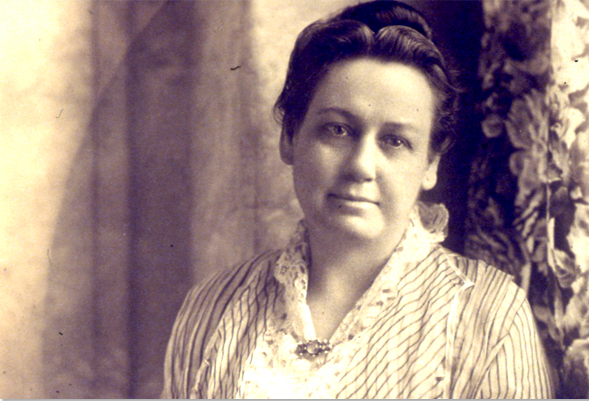
Brilliant Exiles: American Women in Paris, Artworks of two Baha’is is exhibited at a major American museum

By Mona Khademi
An exhibition at the Smithsonian’s National Portrait Gallery in Washington, D.C., marks a major accomplishment for Baha’i artists. Brilliant Exiles: American Women in Paris, 1900-1939 opened on April 26 and is the first exhibition to showcase together the artworks of two Baha’is: Laura Clifford Dreyfus-Barney, and her mother, Alice Pike Barney.
The exhibition spotlights 57 American women involved in art, writing, dance, fashion, music, and theater, who relocated to Paris in search of self-reinvention and discovery. Robyn Asleson, the curator of this exhibition, writes that Paris was a “particularly attractive destination for women who were impatient to move beyond the societal expectations and constraints that limited them in the United States—restrictions on gender, sexuality, and race.”
Born in 1857, Alice Pike Barney financed the visit of the Baha’i scholar and teacher, Mírzá Abu’l-Fad.l, to Washington, D.C. in 1901, visiting ‘Abdu’l-Baha in Akka in 1905, and hosting Him in Washington, D.C. in 1912. She was attracted to the Baha’i Faith because of its progressive teachings. The four pieces from Alice featured in this exhibition were donated to the Smithsonian American Art Museum (SAAM) by her daughters. On the SAAM website, Alice is described as such:
Defying social and family expectations, the wealthy, often eccentric Alice (1857–1931) zestfully committed herself to the arts and became known for her lively art salons, bohemian lifestyle, and unusual family. Alice and her counterparts in other cities represented a new social type: women who lived proper upper-class lives but did not follow the rules, using their wealth and privilege to buy themselves freedoms and to promote causes the rich did not customarily embrace.
One piece, a 1902 pastel drawing by Alice Pike Barney of her daughter titled, Laura Attentive, is exhibited for the first time, fifty years following Laura’s passing. Asleson wished to emphasize in the wall text of this drawing that Laura was a Baha’i, and referenced the fact that she had met ‘Abdu’l-Baha, writing:
In 1900, Laura Barney began a quest for spiritual enlightenment and global peace. She adopted the Bahá’í Faith in Paris and became one of its most influential Western followers. Bahá’í principles such as gender equality, the unity of humanity, and world peace greatly appealed to her.
On a visit to Acre (then in Palestine), Barney met with the leader of the faith, ‘Abdu’l-Bahá. During meals, she wrote down his responses to her questions about religion. She published them as Some Answered Questions in 1908. The book is considered a sacred text of the Bahá’í Faith. It has been translated into forty languages and reprinted many times.
Under Barney’s influence, her mother also became a Bahá’í. In her drawing Laura Attentive, Alice [Pike Barney] highlights her daughter’s observant, wide-open blue eyes. Was she reflecting on Laura’s new role as a dedicated student and recorder of spiritual teachings?

Laura is best known amongst Baha’is as the person who posed questions to ‘Abdu’l-Baha and compiled His answers in Some Answered Questions. She was also a philanthropist and active with several international organizations that worked for peace and women’s rights. A bust sculpted by Laura of her older sister Natalie is included in the exhibit. The wall text for this work states:
Laura Barney emphasizes her sister Natalie’s identity as a poet in this sculpture. Gazing into space, she appears lost in contemplation. Bilingual from an early age, Natalie wrote poetry, plays, essays, memoirs, and epigrams in French. At her weekly salon, she raised awareness of recent literary works, especially those by women. In the service of cross-cultural exchange, Barney even tried translating Gertrue Stein’s perplexing prose into French. The style of this bust recalls the neoclassical “Temple to Friendship” in Barney’s Paris garden, where she hosted many of her events.
Natalie Barney (1876-1972) was the inspiration behind an entire gallery room at the exhibition, which includes the works of her mother and sister. Natalie was a writer of poetry, plays, and epigrams, inspired by her gay feminist identity. For almost six decades, she held literary and cultural salons at her home every Friday night in Paris. They were attended by internationally known writers and distinguished guests from Europe and the United States.
While Natalie Barney never became a Baha’i, she visited ‘Abdu’l-Bahá on multiple occasions in Paris and London. He shared with her that God had given her fruitful seeds of great capacity that she must sow in fertile soil to yield worthy harvests.
Laura continued her loving relationship with her sister until the end of her life. Being aware of this relationship and out of respect for Natalie, ‘Abdu’l-Bahá, in numerous Tablets over the years, asked Laura about her and sent His greetings to her.
Laura was studying dramatic arts and sculpture in Paris when she heard about the Baha’i Faith in 1900. She visited ‘Abdu’l-Baha that same year and traveled to visit Him at least seven more times, staying from a few days up to several months. She also had the honor of spending time with Him in the United States. The young artist gave up pursuing her craft, delving into Baha’i activities and promoting the principles that were dear to her heart.
In addition to Paris’ burgeoning arts scene of the early 1900s, the Baha’i community was also making great strides as a hub for Baha’i development and early visits to ‘Abdu’l-Baha. Paris became the first Baha’i center of activity on the European continent, after ‘Abdu’l-Baha instructed May Maxwell (née Bolles) to stay there and teach the Faith. Baha’i philanthropist, feminist and suffragist Phoebe Hearst and Alice Pike Barney became friends in Paris.
With the support of ‘Abdu’l-Baha prayers ‘for confirmations and assistance for her’ Laura chose a path of service to the Faith and followed it for the rest of her life.
Every step she took until the end of her life was taken to fulfill the vision of her Faith of bringing peace, human rights and gender equality to the world. It is remarkable that fifty years after her passing, Laura Barney, this spiritual and multifaceted woman, is continuously recognized.
Mona Khademi is the author of ‘The Life of Laura Barney,’ published by George Ronald.




